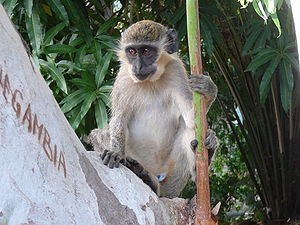Western green monkey
| Western green monkey | ||||||||||||
|---|---|---|---|---|---|---|---|---|---|---|---|---|

Western green monkey |
||||||||||||
| Systematics | ||||||||||||
|
||||||||||||
| Scientific name | ||||||||||||
| Chlorocebus sabaeus | ||||||||||||
| ( Linnaeus , 1766) |
The western green monkey ( Chlorocebus sabaeus ) is a species of primate from the family of vervet monkeys (Cercopithecidae). It is one of the six species in which the vervet monkeys are differentiated in the more recent classifications.
features
Western green monkeys have yellow-green fur on top , the underside is lighter, almost whitish, and the face is dark. The tip of the tail is colored golden yellow, as well as the back of the thighs and the cheek hairs. In contrast to the other vervet monkeys, the hands and feet are brightly colored and the characteristic light hair on the forehead is missing. The scrotum is also lighter than in the other species. These monkeys reach a head body length of 40 to 60 centimeters and a tail length of up to 70 centimeters and a weight of 4 to 6 kilograms, whereby the males are significantly heavier than the females.
distribution and habitat
Western green monkeys are native to western Africa, their range extends from Senegal to the Volta in Ghana . The species was introduced on Cape Verde and the Caribbean islands of St. Kitts and Nevis and Barbados . They are not fussy about their habitat and inhabit both forests and more open areas like savannas.
Way of life
The way of life of the western green monkey should correspond to that of the other green monkeys. They are diurnal and stay on the ground more often than other vervet monkeys , although they can climb well. They live in large groups that consist of a few males, many females and their offspring and can contain up to 80 animals. In the groups, males and females establish a distinctive hierarchy, which is expressed, among other things, in access to food resources and mutual grooming.
They are omnivores that eat fruits, shoots and other parts of plants, but also insects. A population in Senegal has adapted to the diet of crabs in convergence with the crab monkey .
Reproduction
After a gestation period of around 160 days, the female gives birth to a single young. The birth falls at the beginning of the rainy season, when sufficient food is available. The young animal is weaned after around 6 months and is sexually mature at 4 to 5 years.
threat
Although they are hunted for their meat in some places and suffer from the destruction of their habitat, the western green monkeys are not likely to be endangered species.
literature
- Thomas Geissmann : Comparative Primatology. Springer-Verlag, Berlin et al. 2003, ISBN 3-540-43645-6 .
- Ronald M. Nowak: Walker's Mammals of the World. 6th edition. Johns Hopkins University Press, Baltimore MD 1999, ISBN 0-8018-5789-9 .
Web links
- KA Cawthon Lang: Primate Factsheets: Vervet ( Chlorocebus sp. )
- Chlorocebus sabaeus inthe IUCN Red List of Endangered Species 2013.1. Posted by: Kingdon, J. & Gippoliti, S., 2008. Retrieved September 4, 2013.





